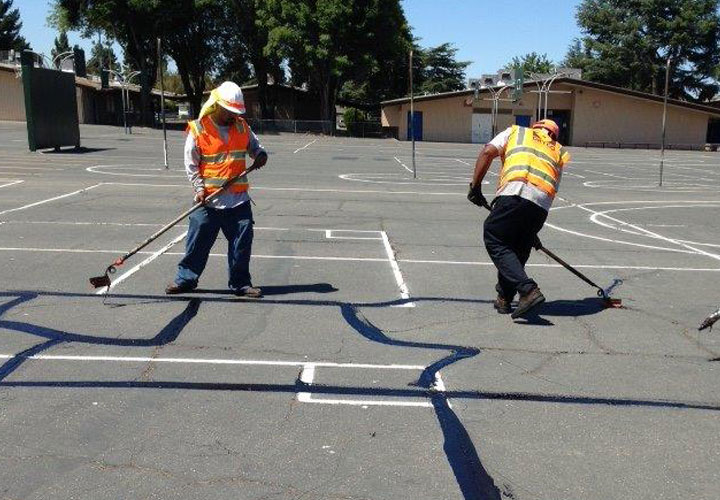Raise Security and Charm: Angled Parking Area Solutions with Asphalt Sealing
Raise Security and Charm: Angled Parking Area Solutions with Asphalt Sealing
Blog Article
Warm Mix Asphalt: A Lasting Service for Sidewalk
Warm Mix Asphalt (HMA) has arised as a leading sustainable selection for pavement solutions, supplying a myriad of ingenious technologies and environmental advantages. As the need for eco-friendly building methods grows, checking out the subtleties of HMA's sustainability can provide useful understandings into the future of pavement services.
Environmental Advantages of Hot Mix Asphalt

Additionally, Warm Mix Asphalt aids to minimize metropolitan warm island effects. Its dark shade soaks up sunlight, minimizing the amount of warmth mirrored back into the atmosphere contrasted to lighter-colored pavements. This can decrease ambient temperature levels in urban locations, reducing the need for a/c and inevitably minimizing power consumption.
Furthermore, Warm Mix Asphalt adds to boosted stormwater management. Its permeable nature allows water to charge and penetrate the pavement groundwater products, lowering runoff and the danger of flooding. These ecological benefits make Hot Mix Asphalt a lasting option for paving freeways and roads.
Energy Performance in HMA Production
Is power performance a critical factor in the production of Warm Mix Asphalt (HMA)? Definitely. Energy plays a significant duty in the manufacturing of HMA, influencing both cost and environmental sustainability. One key facet of energy efficiency in HMA production is the use of warm mix asphalt (WMA) innovations (regrading). WMA enables the mixing and positioning of asphalt at lower temperature levels contrasted to typical warm mix asphalt, leading to reduced energy intake throughout production. This procedure not just reduces fuel usage yet additionally lowers greenhouse gas emissions, making it a much more eco-friendly option.
Furthermore, innovations in plant innovations have actually led to more energy-efficient HMA production processes. By enhancing energy use in HMA manufacturing, the sector can minimize its carbon impact while preserving premium pavement materials.
Recyclability of Warm Mix Asphalt
The recyclability of Hot Mix Asphalt (HMA) is a crucial aspect of its sustainability and long-lasting ecological influence. HMA is one of the most recycled materials in the USA, with over 100 million heaps of recovered asphalt pavement (RAP) being reused yearly in brand-new sidewalk building and construction. Reusing HMA provides several ecological advantages, such as minimizing the requirement for virgin products, decreasing power intake during manufacturing, and decreasing the amount of waste sent to garbage dumps.
The procedure of recycling HMA includes grating the existing pavement, crushing it right into smaller sized pieces, and blending it with brand-new accumulation and asphalt binder to produce a recycled mix. Generally, the recyclability of HMA plays a substantial function in promoting lasting techniques within the pavement industry.

Long-Term Performance of HMA
Asphalt pavements show durability and durability over an extended duration, reflecting the browse around these guys long-term performance of Warm Mix Asphalt (HMA) The longevity of HMA can be credited to its capacity to stand up to rush hour tons, extreme weather, and the effects of aging. Studies have revealed that properly designed and appropriately constructed HMA sidewalks can last for twenty years or even more with regular maintenance. The secret to maximizing the long-term efficiency of HMA depends on using top notch materials, following best practices in building and construction, and carrying out reliable maintenance approaches. Correct water drainage, routine this assessments, and timely repairs are essential for preserving the structural honesty of HMA sidewalks with time. Additionally, improvements in HMA technology, such as using polymer-modified binders and warm mix asphalt, have even more boosted the toughness and longevity of HMA pavements. By focusing on top quality construction and upkeep methods, HMA continues to show itself as a cost-effective and lasting option for long-lasting pavement facilities.

HMA: Resilience and Sustainability
Showing both resilience and sustainability, Warm Mix Asphalt (HMA) has actually ended up being a cornerstone in the construction of resilient pavement frameworks - angled parking. HMA's toughness comes from its capacity to withstand hefty tons, harsh climate condition, and high website traffic volumes, making it a dependable choice for roadways, freeways, and airport runways. The make-up of HMA, which usually includes accumulations, binder, and filler, plays a crucial function in improving its longevity and resistance to tear and use
Furthermore, HMA's sustainability exists in its recyclability and energy-efficient manufacturing procedure. The capability to reuse recovered asphalt sidewalk (RAP) in new HMA mixes lowers the demand for virgin materials and decreases the environmental impact of pavement building and upkeep. Additionally, the top article power effectiveness of creating HMA hinges on its lower mixing temperatures compared to other sidewalk materials, bring about lowered energy intake and greenhouse gas exhausts.
Final Thought
In verdict, warm mix asphalt (HMA) supplies a lasting solution for sidewalk with its environmentally pleasant characteristics. HMA's recyclability, power performance in manufacturing, and lasting resilience make it an environment-friendly option for roadway building.
HMA is one of the most recycled products in the United States, with over 100 million lots of redeemed asphalt sidewalk (RAP) being recycled yearly in new sidewalk building.The process of recycling HMA entails crushing the existing sidewalk, squashing it into smaller pieces, and mixing it with new accumulation and asphalt binder to create a recycled mix.Asphalt pavements demonstrate toughness and strength over an extensive period, reflecting the lasting performance of Warm Mix Asphalt (HMA) Additionally, developments in HMA modern technology, such as the use of polymer-modified binders and cozy mix asphalt, have additionally enhanced the sturdiness and longevity of HMA pavements. The capacity to reuse recovered asphalt sidewalk (RAP) in new HMA blends lowers the demand for virgin products and decreases the environmental influence of pavement building and construction and upkeep.
Report this page